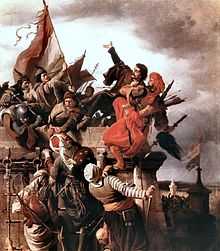Titusz Dugovics
| Titusz Dugovics Dugovics Titusz | |
|---|---|
 The heroism of Titusz Dugovics | |
| Born | Unknown |
| Died |
21 July 1456 Siege of Belgrade |
Cause of death | Self-sacrifice |
| Other names | Titus Dugović |
| Religion | Roman Catholic |
| Relatives | János Hunyadi |
Titusz Dugovics or Titus Dugović (Hungarian: Dugovics Titusz, Serbian: Титус/Тито Дуговић; * ? ; † 21 July 1456) was a mythical Hungarian soldier of Serb or Croatian ethnicity who was stationed during the Siege of Belgrade by the Ottoman Empire's forces in Belgrade. He was charged after his death and the successful defense of Belgrade after the repulse of the Ottomans into a hero. He was also a soldier of János Hunyadi and participated in the Battle of Varna (1444).
However, the historical truth of his existence is in some doubt, because all known records that describe him are of highly questionable veracity.[1]
The siege
Nándorfehérvár was at this time under the command of Hunyadi. From 4 to 22 July 1456, Nándorfehérvár was besieged by the Sultan Mehmed II. After ongoing, fierce battles, Ottoman troops attacked the city walls on 21 July, and a Janissary succeeded, according to legend, to climb a turret and momentarily hoist the Ottoman banner. It was immediately overthrown by soldiers in the same moment that Dugovics grabbed the bearer. As a result, both Dugovics and the standard-bearer plunged from the walls to their deaths.
This heroic act was significant in the repulse of the Ottomans and honours the memory of the defenders of Nándorfehérvár.
Fictional person?
In his study,[2] historian Tibor Szőcs claims Titusz Dugovics did not exist. A familiar figure in Hungarian history, Dugovics is the embodiment of anti-Ottoman resistance and self-sacrifice. This heroic deed by him has served as the subject of numerous works of literature and art science the middle of the 19th century, and several streets in Hungary have been named after him.
Nevertheless, an analysis of the available sources proves that the story cannot be considered as historically accurate. The heroic act was first documented in Antonio Bonfini's chronicle written at the end of the 15th century, where an anonymous Hungarian fighter is mentioned. The same story is told by both Bonfini and the Serbian Konstantin Mihailović, in relation to the Siege of Jajce in 1464, featuring an unnamed soldier as well. Early modern-era Czech historical literature by Jan Dubravius also refers to the hero of Belgrade/Nándorfehérvár as being unknown, but defining his nationality as Czech.[3]
From the end of the 18th century, with the forming of Hungarian national consciousness, the valiant soldier had been regarded as a national hero and role model. Imre Dugovics, a member of the Western Hungarian noble family of Croatian origin, took advantage of that.[4] In 1821, by means of three false documents, he attempted to verify that the anonymous fighter had been an ancestor of his family, called Titusz Dugovics. The name was made known to the public by Gábor Döbrentei, a recognised scholar of the period, who had been deceived by the false documents, and published them in study.[1] Thus, Titusz Dugovics and his story soon became (and have ever since remained) a part of Hungarian historical consciousness, although his character should not be considered more than early-19th-century fiction. The only element of the story that may be accepted as authentic is that of the unknown soldier described by Bonfini and Konstantin.[1]
References
- ↑ 1.0 1.1 1.2 "Így lett romantikus nemzetképünk hőse Dugovics Titusz". www.mult-kor.hu. Retrieved 7 May 2012. (Hungarian text: " A 15. századi források vizsgálata azt mutatja, hogy keringett valamiféle történet egy ismeretlen katonáról, aki így adta bizonyságát hősiességének. A 18-19. század fordulóján ezt a vitéz tettet fedezte fel újra a magyar történelmi emlékezet, amely a romantikus nemzeti múlt-kép egyik fontos epizódja lett. Az 1820-as évek elején ezt a hírességet használta ki Dugovics Imre, aki saját családját kívánta rokonságba hozni a belgrádi hőssel. Céljai elérése érdekében a hamis oklevelek gyártatásától sem riadt vissza. Azonban ő sem gondolta, hogy Döbrentei Gábor lelkesedésének köszönhetően Dugovics Titusz alakja bekerül a nemzeti panteonba. " - Translation: "The 15th-century sources show that there was a story about an unknown soldier who proved his bravery by his action. At the turn of the 19th century the Hungarian historical memory re-explored this heroic deed, which thus became an important part of the nation's romantic past. At the beginning of the 1820s, a certain Imre Dugovics took advantage of this famous act when he wanted to establish a relationship between his family and the hero of Belgrade. He actually falsified records to achieve his aim, but even he never counted on Titusz Dugovics making it into the national pantheon by historian Gábor Döbrentei's enthusiasm")
- ↑ Szőcs 2009, p. 3–35.
- ↑ Péter Hahner (2010). "19. Dugovics Titusz önfeláldozó hőstettet hajtott végre Nándorfehérvár védelmében". 100 történelmi tévhit. Budapest, Hungary: Animus Kiadó. pp. 52–54. ISBN 9789639884953.
- ↑ Dugovics Titusz legendája kipukkadt
Bibliography
- Szőcs, Tibor: Egy "legendás" hős: Dugovics Titusz története. Hadtörténeti Közlemények, 2009. p. 3-35.
- Döbrentei, Gábor: Dugovics Titus, ki magát, csakhogy nemzete győzzön, halálra szánta. 1824.
- Nagy, Iván: Magyarország családai címerekkel és nemzedékrendi táblázatokkal. Pest, 1858.
- Balogh, Gyula: Vasmegye nemes családjai. Szombathely, 1894.
- Kempelen, Béla: Magyar nemes családok. Budapest, 1912.
- Porkoláb, István: Celldömölk Kismáriacell szabadalmas mezőváros története. Celldömölk, 1927.
- Dömötör, Sándor: Dugovics Titusz hősi halálának 500. évfordulóján. Dugovics Titusz vasi kapcsolatai. Vasmegye, 1956. 171. sz. (júl. 21.) p. 4.
- Nádasdy, Lajos: Legenda vagy valóság Dugovics Titusz nagysimonyi származása? Új Kemenesalja, 1994. május 26. p. 5.